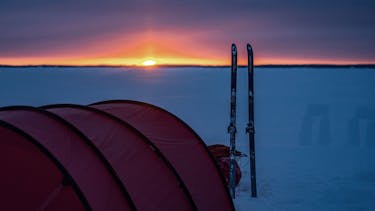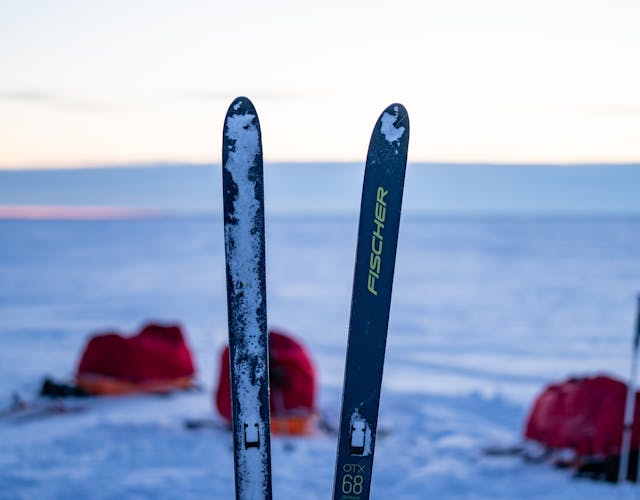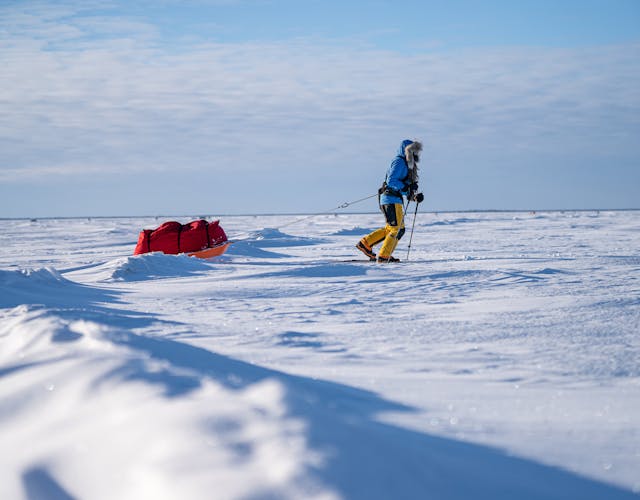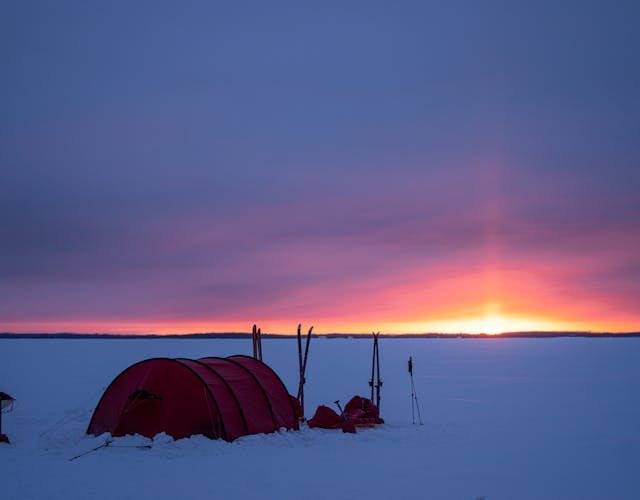"Try taking one of your insoles out," I advise Greg at one of our brief breaks from skiing. It's cold, roughly 10 F degrees below zero (-23 C), overcast, and blowing snow. Typical January conditions on Lake of the Woods in northern Minnesota.
We are on day five of my eight-day Level 1 Polar Training Course. Greg is one of five participants who have enrolled to learn and refine their winter expedition knowledge and skills. With various backgrounds and goals, every student is here to train in conditions eerily similar to Antarctica or the Arctic.
"Problem-Solution," I remind him of one of my many expedition mantras. In his 'other' life Greg is a focused and very successful CEO. But out here on the ice in a whiteout, he hesitates. I suggest he put on his big down jacket, get a warm drink, and then quickly untie his ski boot and remove his insole.
"Better to fix the problem now than develop a blister and become a bigger problem." I bend down to help Greg untie his ski boot. In conditions like these, our margins for error are so small that it wouldn't take much to tip the scales against us. Hypothermia or frostbite can happen within a few minutes if not properly protected.
Luckily, we have prepared for moments like this. Greg quickly removes his boot, pulls out the insole and is ready to ski again in no time. Later in the tent, he would exclaim how much better he felt - both physically and philosophically - after making the adjustment to his boot.

Every year I lead a variety of guided polar expeditions and training courses. From the North and South Poles and many cold places in between, my focus is to teach modern-day techniques of self-supported expedition style polar travel.
I've spent years of my life in one frozen place or another eking out miles as I ski for weeks and months at a time. I've completed more North and South Pole expeditions than any other American in History. While I love the personal challenges of completing difficult objectives in some of the most extreme environments on the planet, I also enjoy sharing my knowledge with others.

This is why I come to northern Minnesota every year. Covering over 950,000 acres on the border of Canada and the US, Lake of the Woods is one of the largest freshwater lakes in the world. The average winter weather is cold and snowy, with temperatures ranging from -5°F to 15°F (-21°C to -9°C). The lake is typically frozen over by December, and the ice can be several feet thick by January.

West of Lake of the Woods lies the Great Plains. Here, winds build into bone chilling arctic blasts that scour the lake's surface and create wind hardened drifts. I can only compare these conditions to Antarctica, the windiest place on the planet.
While these conditions may seem daunting, we prioritize safety and always have a plan in place to deal with unexpected situations at Lake of the Woods. Participants are taught how to make decisions based on weather and terrain as well as how to communicate effectively with their team members. By experiencing these conditions firsthand in a very real way, participants gain a deep understanding of the challenges and rewards of polar exploration.
They also learn how to adapt to changing conditions and make the most of the resources available to them. This knowledge and experience will serve them well in their own polar expeditions, as they will be better prepared to handle whatever weather conditions come their way on expeditions to the North or South Poles, across Greenland, or wherever their cold-loving dreams take them.
Near the end of our five day 'mini' expedition on Lake of the Woods, I notice a distinct change in the team dynamics of our group. I call it “Polar Swagger,” but it’s really the confidence that comes from honing skills and self-reliance. I watch in awe as tents get set up faster and equipment is stowed effortlessly in sleds.
On the trail, long bone-chilling snack breaks become quick energy refills before skiing again. We stay warm throughout the day. There is an overall ease at which everyone is completing the myriad daily tasks which just a few days earlier seemed pitched battles of life and death. At this point, my job is less about leading and more about following.
And Greg? He became my star student and is currently planning Last Degree Expeditions to both the North and South Poles.








